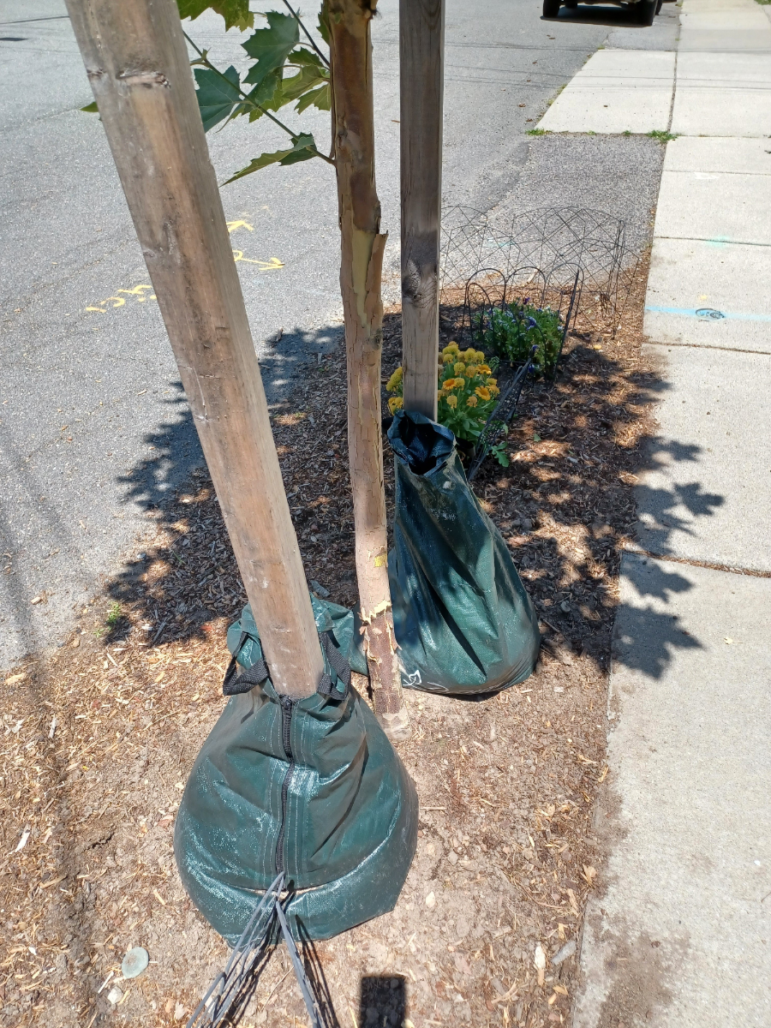
Trees for Watertown In times of drought, watering bags like these keep young trees alive.
By Jim Briand of Trees for Watertown
When the rain stops falling, we tend to focus on the areas that respond most visibly—the lawn and the garden. A brown lawn and withered blossoms demand our attention with the hose and the watering can. Yet the most important plants in the yard — the trees — suffer as well.
Prolonged droughts affect trees in serious ways, but the impact is not always immediately visible. In fact, it can take one to two years for the damage to become apparent. During a drought, the amount of moisture in the soil is reduced to the point that a tree’s roots are unable to absorb moisture. If these conditions persist, the fine roots that deliver moisture to the tree die back, increasing the stress on the tree.
Once the roots are damaged, it can take days or weeks to regrow critical root fibers — even if the rain returns. This root loss can in turn lead to tree stress, making the tree vulnerable to insect pests such as beetles and borers.
When we consider Watertown’s trees in this time of drought, which trees are most vulnerable? The first thing to consider is the setting of the tree. Trees in shallow soils can be more susceptible to the impact of drought. This is particularly true of trees growing in shallow planters or compacted soils. Such trees, often including street trees in tight Watertown spaces, can develop shallow roots and be vulnerable to drought.
The good news is that some types of trees are naturally resistant to drought. These include Honey Locust trees, Gingko trees and Eastern Red Cedars. Drought resistant trees have thicker and waxier foliage that allows them to minimize their water loss into the air.
How can you tell if your tree is suffering from the drought? The symptoms are similar to those
you see in your garden: daytime wilting, yellowing leaves, and leaves that have a burnt look to them. If the dry conditions are sustained, further symptoms can appear such as thinning leaf cover, diminished growth, or even loss of entire tree sections. Young trees are the most vulnerable, as they have not established their roots, but even mature trees can be killed by an extended drought — and an extended drought is what Eastern Massachusetts is experiencing now.
So what can you do? In Watertown, the City supports young street trees by installing watering bags to help them survive their first years. You have probably seen them, those pairs of dark green bags on either side of the tree. These bags gradually disperse water to the tree in a way which is most beneficial for growth and survival, via small holes in the bottom of the bag. The City fills the bags on a regular basis, but if during the drought, you see empty bags on a tree near your house, fill them and ask your neighbors to do the same.
Please consider watering mature street trees as well. Trees should receive at least twenty gallons of water a week — and even more in a heat wave. For trees with no watering bags, water under the canopy with a hose set at a low trickle for about an hour. Slow watering is best so that the water seeps deep into the soil.
And don’t forget your backyard trees. If trees in your yard are showing signs of drought, please water them too.
As Trees For Watertown’s Jessica Grimsby notes, “The summer’s heat brings the “hotter than a match head” line in the old song, Summer in the City’ to life. For us, it just means being uncomfortable. For the trees that give our streets shade and beauty, this heat can be a matter of life or death.”
Thanks for your question about water restrictions in Watertown. There are none now and I can’t think of one’s in the last dozen years or so. I think it is more common in towns with local water sources. Watertown gets water from the MWRA.
Also, a reminder that comments must be signed with a full name.